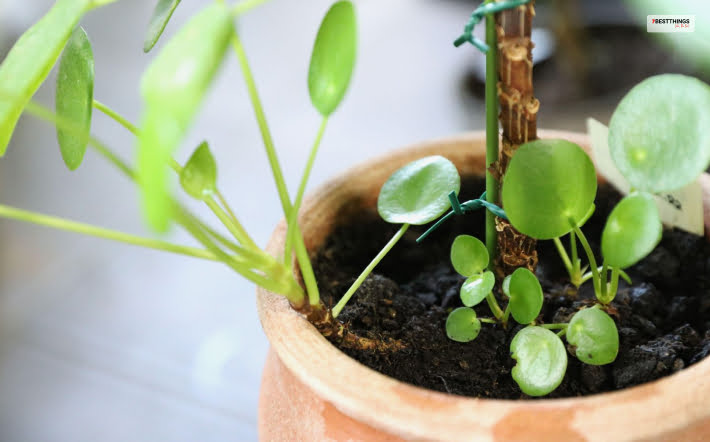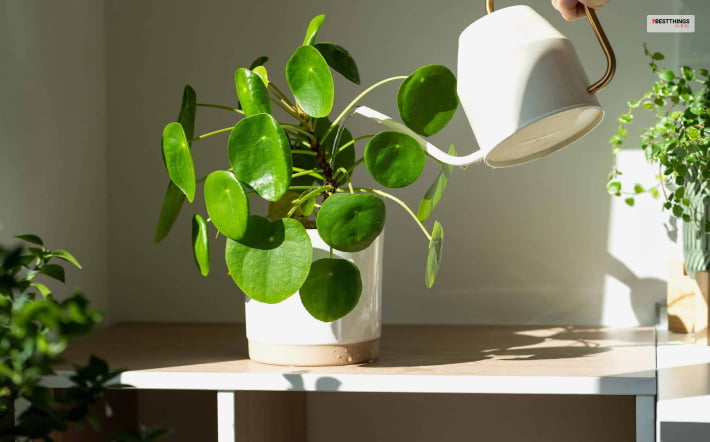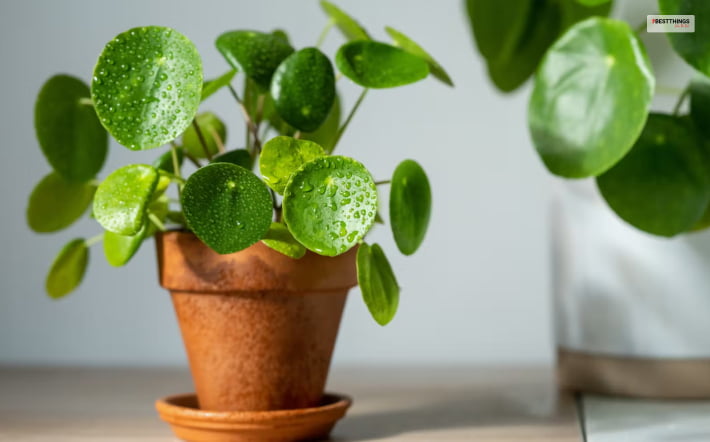My first encounter with a Chinese money tree happened at my friend’s place. Being a plant mommy, it did not take me long to fall in love with the distinct foliage of the plant.
Also, it was springtime. The white petite flowers of the plant left a lasting impression on me.
So, I brought home one. However, charmed by the beauty of the plant, I tried propagation, and today I have six Chinese money tree plants in my house.
Are you also planning to grow this plant at your house? Here is a detailed guide on how to propagate the plant and how to take care of it.
Contents
Things You Must Know About Chinese Money Tree
A Chinese money tree has many names. Thanks to the unique shape of the leaves, they are also known as pancake plants or coin plants.
Growing and looking after coin plants is easy. And once you have a coin plant in your house, you can grow more plants from it and share them with friends. That’s why many people call it the friendship plant.
Here, I have curated seven points you need to know for successful propagation and the lush foliage of the plants.
You don’t need to have a royal garden. Growing these petite beauties will add a quaint charm to your home and garden.
Money Tree Propagation

Once you have a coin plant in your house, you will know that they grow offshoots very fast. Along with the place around the main root system of the plant, offshoots can grow from the nodes. So, you will see offshoots along the main stem of the money tree.
If the money tree has offshoots, let them become a few inches tall. Then, separate the offshoots from the mother plant. You will have to dig the soil first. By digging the soil, you will find the roots of these offshoots.
So, separate these offshoots from the plant using a clean and sharp knife. You can also use pruning shears. Make sure that you are cutting the roots from at least one or two inches below the soil.
You cannot keep the cutting aside for a long time. In fact, you need to plant them into the moist soil of a different container almost immediately.
In addition, you have to keep the soil moist until the offshoots have not grown proper roots. Once they have a proper root system and you can witness a little growth, you can start regular watering.
Money Tree Soil Requirements

This plant needs soil with a proper drainage facility. You need to mix the soil with cocopeat or perlite to enhance its draining capacity. The money trees will not survive if it gets waterlogged.
Water Requirements

These plants need moderate watering. So, you cannot overwater them and cannot keep them dry, either. Touch the soil before watering, and when the upper surface is dry, water the plants thoroughly.
You can even keep an eye on these plants as the leaves become droopy when they need watering. On average, watering every 2-3 days is a good idea.
Temperature Requirements

If you want a money tree in your house and plan your interior design accordingly, you have to make sure that it receives adequate Sunlight.
Your plan will thrive well indoors. However, if you want them to flower during the springtime, you will need to arrange adequate natural light for them.
These plants thrive well in moderate weather conditions and can stand temperatures as low as 10 degrees Celsius. Extreme heat is bad for the plants.
So, if it’s summer and the temperature is soaring higher than 20-25 degrees Celsius, you keep it indoors and at a place where the temperature is a little low.
How To Do Potting And Repotting Of Chinese Money Tree

You can grow a money tree in a ceramic, terra cotta, or plastic pot. However, if you choose a terracotta pot for the plants, you will need to water them more frequently. Terra cotta pots absorb more water.
While repotting, make sure that the offshoots are cleaned or separated properly. Be careful about not hurting the root of the plant.
Also, refresh the soil and add some organic mix. Refreshing the soil helps better air circulation.
The ideal time for repotting these plants is spring or summer time. Do repotting once a year to have a lustrous foliage.
Money Tree Care To Keep Pests At Bay
Common pests that attack these money trees are mealybugs. These can also be attacked by spider mites, scale, and different types of fungi.
To get rid of mealybugs and other pests, I use a homemade mixture of garlic, onion, pepper, and detergent. You will also find readymade solutions in the market.
These plants are delicate. So, for them, the homemade solutions will be the best. Chemical solutions can be stronger and harsher for the plants.
Also, you can avoid the attacks of mealybugs and pests on your plants with proper watering and feeding schedule. Overwatering and overfeeding the plants with excessive fertilizer are one of the major reasons for mealybug attacks.
Further, nitrogen spray once in a while is great for the growth of plants. However, too much of it can boost the growth of mealybugs.
Along with the pest attacks, there are some other problems visible in the Chinese money tree. The leaves of the plants can get curled up, or they can become yellow and brown. There can even be instances of too many falling leaves.
Curling Up Of Leaves
The leaves get curled up if a plant does not get enough indirect sunlight, or the surrounding air has less humidity. Curled leaves also indicate excess or inadequacy of watering.
Brown Colored Leaves
The leaves of these plants get brown if they receive more Sunlight and there is not enough humidity in the air.
Yellow Leaves
The leaves will turn yellow if you are watering the plants too much.
How To Make The Money Tree Bloom?
If you want to boost flowering, you have to keep these plants in a colder place. A temperature below 10 degrees Celsius is ideal for the plants to promote flowering.
Final Words
Growing a Chinese money tree will augment the beauty of your house. The unique shape and soothing green shade of the leaves are very rejuvenating for your eyes.
Further, traditionally, this plant is believed to bring money and affluence to a household. So, it’s an auspicious plant to have in your house.
Follow the propagation and care plans I have shared here, and your house will be filled with these plants. Happy gardening!
Also read












